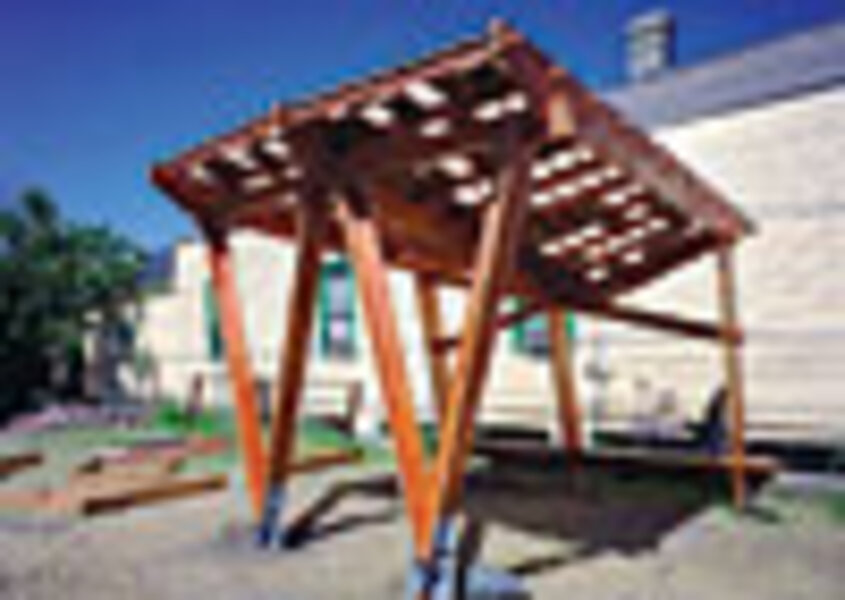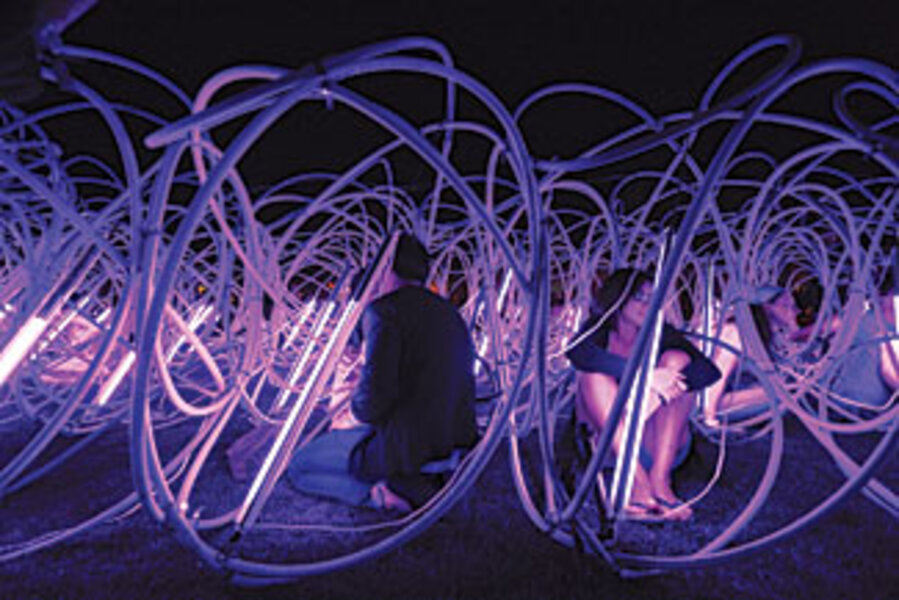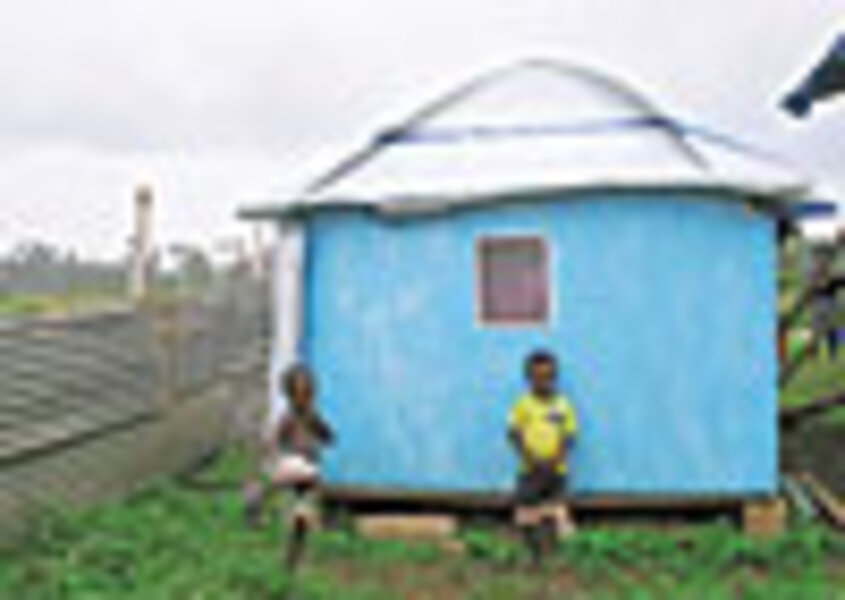Fleeting architecture
| Los Angeles
From a proposed temporary main stadium at the heart of Chicago's 2016 Olympics bid, to newly designed ecofriendly shelters with a shelf life of 18 months being sent to Afghanistan, to a gallery enclosure for the 2008 Venice Biennale made entirely of string, the walls that define modern living space – the architecture of today – are becoming increasingly ephemeral. Driven at one extreme by a cultural thirst for "the new" and at another by rising global needs of displaced populations, this dematerialization will only continue to expand, say architects and cultural analysts. And as money for big-ticket buildings runs scarce and pressures to reduce humanity's environmental impact mount, a symbiosis between experimental and utilitarian elements in the architectural landscape can only grow.
"We are becoming a temporary society," says New York architect Marc Spector.
"There is an accelerating temporality to modern life," says Los Angeles designer Benjamin Ball, whose firm, Ball-Nogues specializes in provisional structures.
This is due in part to the fact that attitudes toward physical space in the developed world have altered dramatically, says Roberta Feldman, who teaches a course on the psychology of space at the University of Illinois at Chicago. "We used to place a huge value on permanence and place, but that's gone," she says, adding "we want the novel, the next, and we're happy to throw away and move on in order to accommodate that." At the same time, growing populations of refugees, disaster victims, and homeless around the globe (the United Nations currently estimates the number of internally displaced persons at 25 million worldwide), are bringing home the increasingly urgent need for creative solutions for impermanent communities.
"We need both the experimental and the useful practitioners at a time like this," says Charlie Hailey, author of "Camps: A Guide to 21st-Century Space." The festival and art circuit have become rich birthing grounds for inventiveness, says Mr. Ball, who recently supervised provisional structures for the Coachella music and art festival, a three-day event in the California desert. The architect worked with a team of students at Southern California Institute of Architecture (Sci-Arc), a professional school in downtown L.A., to brainstorm artful but practical answers to the needs and wants of festivalgoers. "Elastic Plastic Sponge," an elaborate confection made of lavender- and khaki-toned PVC piping, was both an illuminated sculpture that lit up the night sky with a soft purple glow and also a misting station for parched patrons as they reveled in 100-plus degree F. heat.
Remnants of the enclosure appeared in the school's Sci-Arc's recent student show downtown. "After this, the materials will be recycled," says Colleen Elkins, Sci-Arc director of development, as she strolls past the jumbled pile of pipes.
Such a brief life cycle is a large attraction for architects, says Ball, many of whom used to wait years to realize a single creation in the real world. "Now there's been this blurring of the line between art and architects," he points out, one that allows designers to try out new ideas much more quickly. This ability to conceive even grand architecture in temporary terms becomes important when a community demands change, as they have in Chicago, where many residents have demanded a low-impact Olympics in the city's 2016 bid.
A traveling exhibit from New York's Cooper-Hewitt, National Design Museum, "Design for the Other 90%," addresses the question of how to translate the freewheeling creativity of a festival setting into useful design. Featured are such items as the Global Village Shelter, a prefabricated, biodegradable laminated cardboard "home" that can be assembled without tools and has been sent to Afghanistan, Indonesia, and Pakistan during recent natural disasters. The new materials, manufactured by Weyerhaeuser, will last up to a year and a half. The exhibit is funded in part by the Lemelson Foundation in Portland, Ore., a nonprofit that seeks out and supports innovative design. Executive director Julia Novy-Hildesley says she has seen a significant shift among young designers in the past decade. "It used to be, not too long ago," she says, "they were all interested in consumer items like making the next jet-ski pack or a really cool toothpaste tube." Now, she says, there is a new sense of moral imperative. "They all want to make the next ecofriendly shelter. They all want to have an impact for the betterment of the planet," she adds.
There may be no more vivid intersection of the wildly experimental and the practical than Burners Without Borders (BWB), a spinoff of the annual Burning Man festival in Black Rock Desert of Nevada – an event devoted to spontaneous, low-impact community creation.
Spawned in 2005 in the wake of hurricane Katrina, the shoestring, all-volunteer BWB works to inspire recruits from around the globe to take the lessons gleaned from their years of creating themed art camps with few resources and apply them to "burning" human needs. The team is currently at work in places such as Pisco, Peru, where they have created a water sanitation system for victims displaced by the recent magnitude 8.0 earthquake.
"We wanted to take all that crazy, experimental energy and pull it back to the other side," says Carmen Mauk, BWB director. To encourage others to do the same, the group recently scraped together $6,500 to disperse grants to 15 similar projects around the world. "We decided to do our own little stimulus package," she adds.
Such communal effort is a hallmark of design in the future, says Mr. Hailey, as is the increasing attention to a concept of architecture as an idea. "We may find that communities will no longer rely on the big monuments such as stadiums or concert halls to define themselves," he says. He suggests that whereas city leaders will not lose an interest in iconic structures such as the Frank Gehry-designed museum in Bilbao, Spain, which became a magnet for economic development and led to the term "the Bilbao effect," they will increasingly rely on temporary constructs instead. He points to such evanescent creations as the artist Christo's "The Gates," in Manhattan's Central Park, as an example of a large-scale, highly engineered, but fleeting work that also served the purpose of helping to define the city's artistic but also functional landscape.
"In the future," he says, "we will begin to see more of the Bilbao effect, but on the fly."







